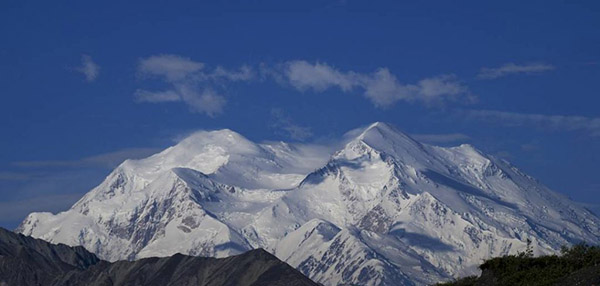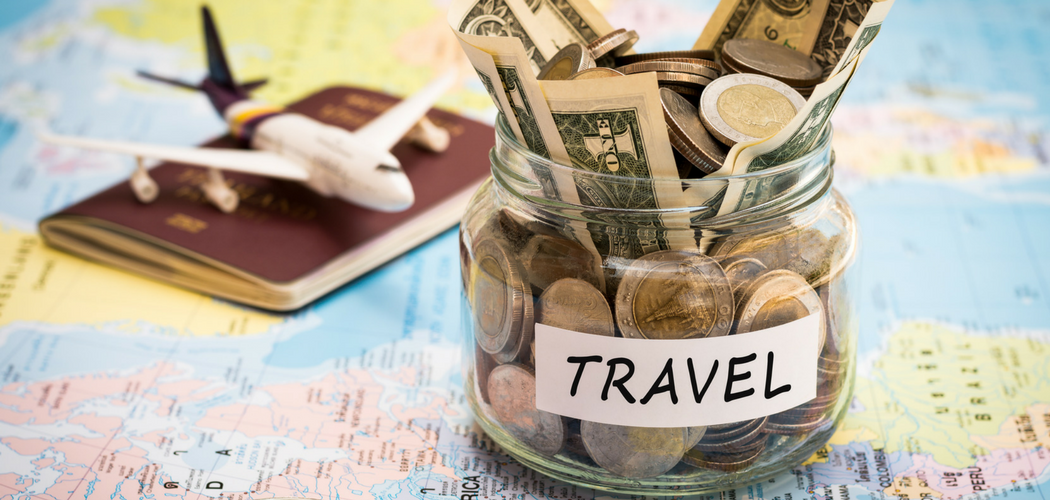![]()
How rare is it to experience the type of freedom in life afforded to you when backpacking?
There’s nothing quite like the open canvas of a new morning in a new place with new faces and no trace of the routine.
You never know where you’ll be tomorrow and for the first time in ages you find yourself where everyone should be: the present.
The present with its new discoveries, insane photos, laughs, envious hostel Skype calls, missed trains, found friends, budget overshoots, ridiculous meals, and dirty laundry.
Through the good and and bad backpacking trips offer more than just sights and sounds, but a way to finally live a little. Let this series show you how to live a little.
Pick your destination

Routes
Backpacking through Thailand has changed dramatically over the years owing to the super commercialisation of the southern islands and the party-first attitudes that come with it.
Whether you want to party all night and sleep the day away on golden beaches or go straight up zen with a quiet and spiritual holiday, you’ll find it all here.
When backpacking Thailand most tourists go for a combination.
You’ll hardly see a backpacking itinerary that doesn’t start in world-class Bangkok. The bustling capital is home to Thailand’s two biggest airports and its central location makes it an undisputable transport hub.
From here most travellers usually head south and a good second stop is the curious ancient city of Ayutthaya, once the world’s largest city in the 18th Century.
Kanchanaburi is a logical third stop and is famous for its Tiger Temple and connection to the legendary film Bridge Over the River Kwai.

Further south along Thailand’s backpacking route is the country’s first beach resort Hua Hin - a weekend escape for Bangkok residents famous for kitesurfing and seafood shacks.
From here head south to the province of Phuket and its endless list of beer bars, Muay Thai stadiums, and beach destinations. From here you’re striking distance to some of the most spectacular island getaways in the world and you’d do well to spend 3-4 in each of Koh Phi Phi and Koh Lanta. Other coastal towns in the region to check out on the way are Krabi Town and Ao Nang.
An optional addition to this itinerary is to first head north to budget-friendly Chiang Mai, the most culturally important city in Northern Thailand and home to hundreds of elaborate buddhist temples. From here you can fly to your more southern destinations with a discount airline.
Budget
Though Thailand was once the king budget backpacking destination of Southeast Asia the influx of tourists has slowly brought prices back to the real world.
That said, a price for a meal in an inexpensive restaurant is about €1.60. If you’re willing to splurge you can get a three-course meal for two in a mid-range restaurant for about €13.90. Expect to pay about 10-15% more than the mean in tourist areas and 10-15% less in more rural areas.
The price of a pint of domestic beer in the supermarket is about €1.60 with bar prices reaching €3-€4. A bottle of water will run you about 22 cents in a supermarket and around €1 in a bar.

When backpacking through Thailand you’ll find an average hostel, extremely basic guesthouse, or Airbnb room for between €9-€15. The prices rise from there with better guesthouses and midrange hotels costing between €25-€45 and nice resorts or boutique hotels starting at around €75.
The standard Thailand travel model for backpackers would be some combination of ‘slumming’ the cheap guest houses for some time and then opting for a resort splurge in one of the island beach destinations. Treat yourself, but don’t go crazy. In all those who are very tight with the penny could easily get by on €25 a day.
The question to ask yourself though is, do you want to just get by or have a little fun as well? If you’re looking to have a couple drinks, eat well, pay the entrance at some sites, and maybe throw in a surf lesson or massage a budget of €50-€60 is recommended.
Getting around: Transportation
Due to the frequency of buses you generally only need to book one day in advance. Internet booking is rare so get your tickets in the terminal. For some fare perspective know that the price from Bangkok to Chiang Mai (700 km) is about €18 for a VIP bus and €8-€10 for second class option.
Whether you’re looking to go up north to Chiang Mai or down south to Surat Thani (a hub that connects into Phuket and later the southern islands) you’ll find a modern system to get you there in comfort. One convenience is that trains can now be booked advance online. Expect to pay about 20% more than the bus.
Tips
If there’s one surefire tip that’ll save you a bunch of money on Thailand travel it’s the knowledge that tipping isn’t a custom.
The idea of leaving gratuity on a meal, taxi, tour service or otherwise is almost exclusively a North-American and European invention. The tradition actually annoys locals and expats alike as it leads to higher prices for services.
In the event of spectacular service a few extra baht won’t be frowned upon, but the idea of the insta-10-15% on top is at best only expected in super touristy restaurants you should be avoiding anyway. On a tight backpackers budget you’ll be glad you didn’t.
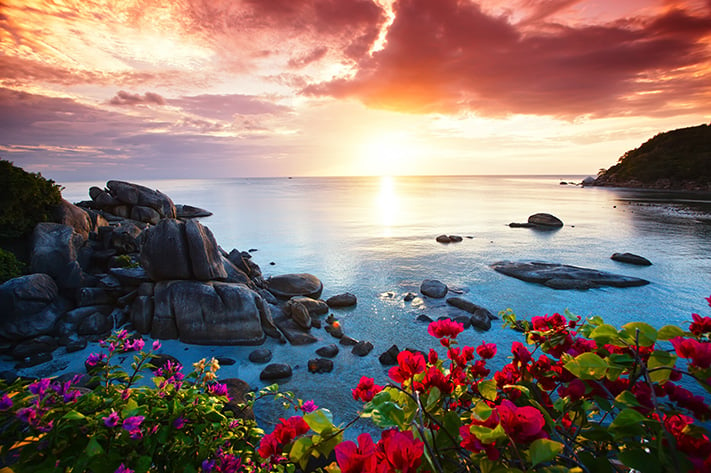
Another thing you can do to save money is to haggle constantly. To a Thai most farang (a foreigner, mostly of European origin) are walking dollar signs to be taken advantage of.
A good rule of thumb is to never accept the first quoted price even if it seems like a good deal. Some of the biggest ripoffs come in taxis and tuktuks, it’s best here to insist on drivers using the meter.
Ask someone working at your hotel what an average ride (or anything else, really) goes for and use that as a springboard. Agree on a price before getting in. The ‘fake walk away’ is also an effective move and is often met with an ‘ok ok!’ response to your price.
When backpacking Thailand know that the time to visit is fairly crucial. In all Thailand is a hot, tropical place that can be unbearable to the unaccustomed.
The standard advice is to travel during the dry season (November to Mid-February) to avoid rains and raging heat. It’ll be slightly more expensive due to the higher amount of tourist activity but at least you’ll be able to move!
The excruciatingly hot summer months of July and September are not recommended for Thailand travel unless you’re really brave.The rainy season (April-June & September-October) offers less crowds and more green for cheaper prices.
When to go
We'll tell you the best time to do this backpacking trip through Thailand. Take notes and start preparing your trip!


Do you feel like travelling?
Discover the best flight offers to fly to Bangkok in Thailand

Routes
When backpacking Italy you first need to answer some basic questions, the first being ‘am I going to see the whole country or focus on a specific part?’.
In general the more industrialised north is more expensive than the rural, beach-spotted southern regions.
If you want to focus on the north it’s best to fly into Milan. From here a very standard route would be Milan-Garda Lake-Venice-Bologna-Florence-Rome. Here you’ll see five of Italy’s major cities while exploring one of the most beautiful lake districts in the world.
Depending on time you’ll also be able to take day trips to other classic cities like Verona, Pisa, and Modena. Leave at least two weeks to do it properly.
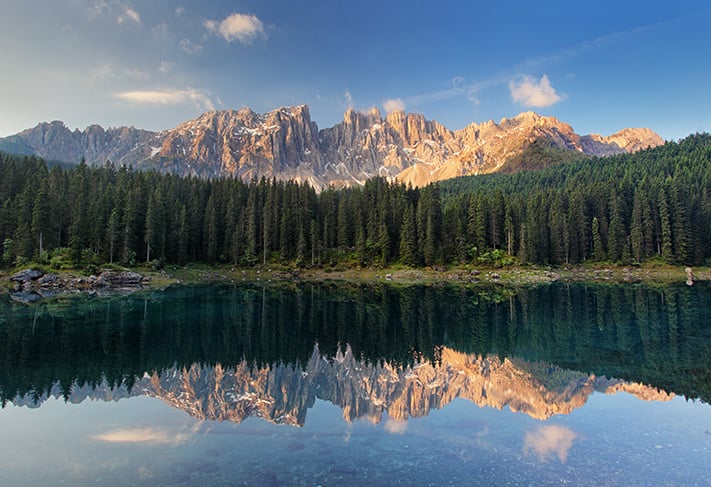
For those looking to explore the south it’s naturally best to fly into Rome. From here a standard route is Rome-Naples-Amalfi-Matera and then either to the regions of Sicily or Puglia (or both).
Aside from the well-known urban destinations the Amalfi Coast offers some of the most stunning turquoise coastline in the world and Sicily and Puglia with their superior, rustic cuisine and ancient villages will make it a holiday to remember. Remember to leave two weeks to do it properly.
Of course, depending on time you could do both itineraries and see the entire country top to bottom in 4-6 weeks.
Budget
It’s perhaps no secret that the land of Gucci and Dolce and Gabbana isn’t the world’s cheapest backpacking destination.
Backpacking Italy won’t get you the run for your money that you’ll get in South America or Southeast Asia but most backpackers (you included?) already knew that before they arrived, didn’t they?
Expect to pay €20-€25 for a bunk in a typical dorm room and €60-€90 for your own room in a low-end hotel. A nice double room in a mid range hotel will cost you between €90-€150 and the high end stuff goes up from there.
Major cities like Rome often have a tourist tax which adds on a couple of euro per night so make sure to check if this is included when booking.

For food the typical tourist menu in an average city centre restaurant goes from €8-€12. This usually includes a starter (a basic salad or soup) and either a pizza or pasta dish with water or wine. Some restaurants include coffee and a dessert of fresh fruit or ice cream. For a fancier restaurant expect to pay about €20-€30 per person.
Tipping isn’t customary in Italy but it’s not uncommon to be added a ‘coperto’ (service charge) of a couple of euros per person. In the event there is none leaving a couple euro on top is just fine.
To save even more money ask for tap water (‘del rubinetto’) and skip the ‘complimentary’ bread which often ends up costing a few euro.
Getting around
Being one of the largest industrialised economies in the world there are tons of ways to get around Italy. When backpacking Italy people usually start (and finish!) by looking at rail pass options which allow preset amounts of travel within a specific time period.
The value here is unbeatable and the 16,000 km coverage of Italy’s rail network means you’ll be able to go virtually anywhere. Options range from 3, 4, 6 or 8 days of travel within a 1-month period with prices starting as low as €118 for EU nationals and €130 for those from outside. These passes get their most value if you’re covering a lot of ground.
Rates for people younger then 26 years old start from 87€.
An even cheaper thing to consider are the coach services. Intercity bus transport in Italy is often overlooked because of traditionally bad services but with the advent of modern, airconditioned, fully ‘wified’ companies like Flixbus the game has changed.
Taking a bus between major cities like Rome and Naples can cost as little as €6-8 and is often not much slower than taking a train. If you’re not in much of a hurry and only doing a few major stops in one region like Tuscany then bus travel is a great option.
Modern Europe is well connected by discount airlines and Italy is no exception. Companies like Ryanair and Easyjet serve every nook and cranny. Whether you take any internal flights will depend on what city you arrive at and where you plan to go from there.
If you’re backpacking through Sicily but fly into Milan for example you may want to check out the flight deals since rail or bus would be expensive and time consuming. Be careful of baggage fees which can double a flight cost in a hurry.
Most major cities have 24 hour transport tickets that include access to all metro, bus, tram, and train services – expect to pay about €5-€7 for a day of travel. For smaller cities single tickets should be between €1-€2.
Tips
It’s no grand revelation but the summer months are really crowded in Italy which means you’ll be queueing up longer, less comfortable on public transport, and more importantly paying more for almost everything.
The backpackers and school groups that flood Italy’s premier destinations generally tail off in the second half of September.
Travel in Italy in late September or in late Spring to ensure you still get some decent weather but don’t feel the full brunt of the tourist chaos.

Italy’s hostel scene isn’t the kindest to backpackers and doesn’t even come close to some of its European counterparts - it’s rare to find hostels with a youthful/energetic feel and most look like stale old hotels from the 70’s that have merely switched out king sized beds for a series of bunk beds.
If your hostel search hasn’t yielded much and you’re looking for cheap accommodation your best bet is to go through Airbnb or find a campsite outside the major cities. Most major cities and coastal towns have campsites (‘campeggi’) where you can find bungalows, caravans, or simple tent pitches for reasonable prices.
With Airbnb it’s no secret there are a ton of places undercutting hotel prices and the added bonus is you might stay with locals that can give you invaluable holiday advice.
Another tip: you can still eat like a king in Italy with very little money if you play your cards right.
Food standards in the country are incredibly high but that doesn’t apply to just restaurants; instead of shelling out €20-30 on a restaurant meal you’ll do just as well going to a local panificio (bakery) or salumeria (deli) and having the people make you a custom sandwich with Italy’s famous meats and cheeses. Grab a bottle of water or a small bottle of wine and you’ll have a top notch picnic for less than a tenner.
When to go
We'll tell you the best time to do this backpacking trip through Italy. Take notes and start preparing your trip!


Do you feel like travelling?
Discover the best flight offers to fly to Milan in Italy

Routes
First know that there are no direct flights to Nepal from continental Western Europe. The closest way in is through Istanbul though most travellers end up coming in through Middle Eastern countries and India. The route proposed here is to see the best of Nepal and won’t include the time intensive trek to Everest, which is a trip all on its own.
Due to airport connections the first stop on most Nepal backpacking routes is UNESCO World Heritage City Kathmandu. It’s a full on sensory attack of smells, noises, and nightlife and an easy way to get acclimatized.
From there a short bus ride takes you to Pashupatinath and its famous open air Hindu cremation rituals. Stop a bit further down the road to see the unmatched exoticness of the Tibetan Buddhist community of Boudha.
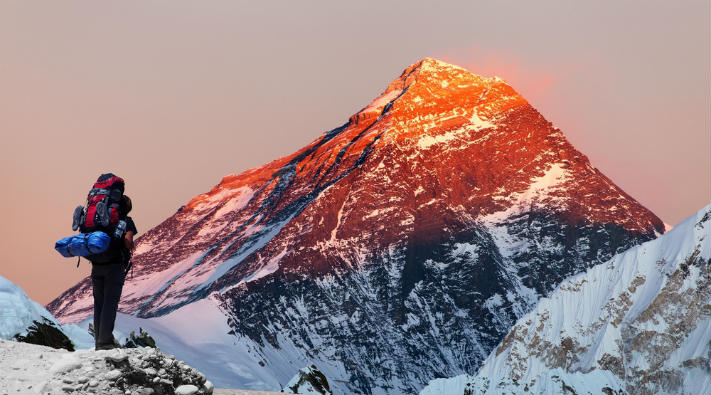
Head further into the Kathmandu valley for a look at the almost too well preserved ancient city of Bhaktapur which is Nepal’s cultural gem - the colourful festivals, elegant art, and indigenous lifestyle on display are something to be seen.
The next stop is bazaar town Bandipur which is a great location for anything easy-going. Move one to Nepal’s biggest tourist centre: Pokhara. From here you’ll have a nearly unobstructed view of the up to 8000m Annapurna and Manaslu ranges as well as the beginning of some of Nepal’s most famous rafting, kayaking, and mountain biking trails. It’s arguably the best place for trekking in Nepal so add a couple extra days and make sure you get to the viewpoint at Poon Hill.
You can’t go wrong finishing the trip in the wildlife-heavy jungle terrain of Chitwan National Park. Whether you’re looking for deer, monkeys, rhinos, and even tigers you’ll be spoilt for choice.
Budget
Before anything you’ll have to buy yourself a single-entry visa for US$25/40/100 (15/30/90 days). This can be bought at the airport with US dollars and small bills are preferable.
One thing that you need to factor into the budget here are trekking equipment costs. Of course, if you’re just trekking Nepal and probably won’t use the equipment again it’s good to know that shoes, headlamps, torches, tents etc. can all be rented for as little as €2 a day. €8-€10 a day for equipment is more than enough.
The cost of a meal of traditional rice or lentil dishes in an inexpensive restaurant in Nepal is about €1.75. For a three course meal in a mid-range restaurant expect to pay about €7 for two people. Beer expenses generally aren’t in line with the low costs found elsewhere so expect to pay €1.80 for a standard pint.
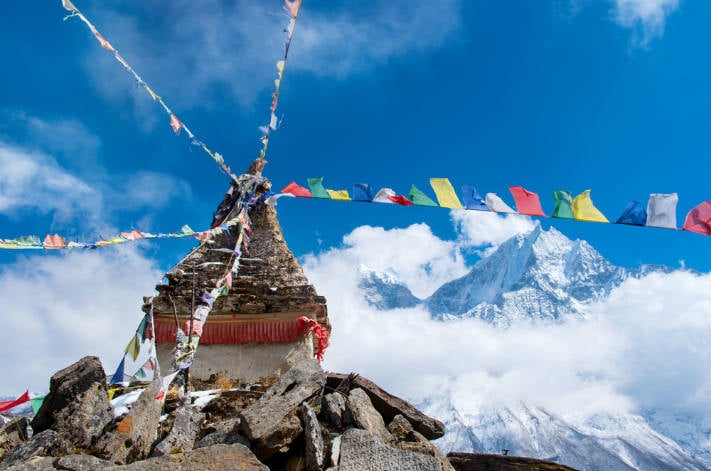
Accommodation is a great bargain in Nepal and you should be able to find hostel beds of varying quality for between €3-€5 a night. Two, three, and four star hotels begin at about €6, €12, and €45 respectively.
Attraction prices in Kathmandu are negligible with the Royal Palace and Swayambhu Temple costing about €1.80 and €4 respectively - don’t expect to pay more than a fiver for anything save the Garden of Dreams at the Royal Palace (about €25).
In all you should be very comfortable with a budget of about €20-€25 a day but it could be done for even less, making Nepal one of the biggest travel bargains in the world.
Getting around
Buying tickets for any bus is done through ticket windows at ‘bas parks’ or in advance via ticket agents.
The other options between cities is quite limited and flights become an option only when the alternative is a day long bus ride. Consider about €85 for an internal flight with any of the main private companies like Agni, Buddha, Gorkha, Sita, or Yeti. A great deal of the air traffic in Nepal does the so-called ‘mountain flight’ and takes tourists for a birdseye view of Everest and the rest of the Himalayas, an attractive alternative to hiking!
Airline bookings are not currently done online and you’ll have to go through a travel agent with US dollars. Overbooking is quite common so make sure you check-in early to avoid getting bumped.
In Kathmandu most major sites will be within walking distance but the small white taxis can be a great value if negotiated properly. Don’t pay more than 500-600 rupees (about €5) to get to central tourist district Thamel from the airport. After that you’re looking at 200-300 rupees (€2.50) for a standard journey.
The micro taxis (small, white minivans) which pick up people much like buses will go for about 15-20 rupees (about 15 cents). Most backpackers in Nepal avoid the suffocating city bus system.
Tips
Backpacking in Nepal can be a nightmare during low season (Jun-Sep) where monsoon rains bring landslides and endless strings of cloudy days that obscure otherwise incredible mountain views. It’s the cheapest time to travel by far if you’re willing to put up with the rain, mud, and leeches that’ll make your Nepal trekking experience difficult.
For clear skies and warm days high season (Oct-Nov) is your best bet even if things are more expensive and crowded. A second choice is the shoulder season (Mar-Apr) with its warm weather and spectacular rhododendron blooms.
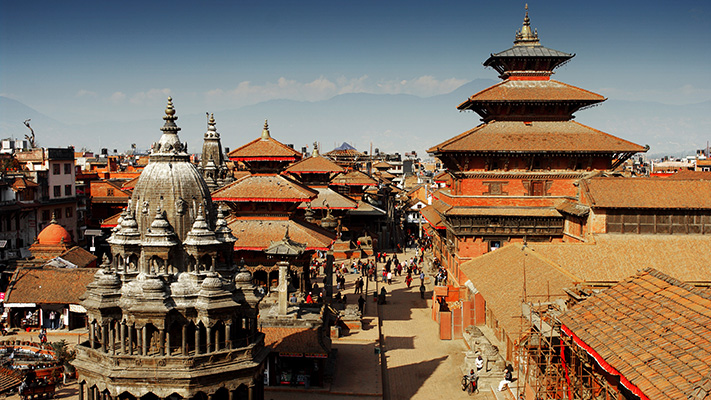
Traditions in Nepal run deep and this goes for things as basic as clothing - as much as cultural norms are changing know that revealing clothing is generally frowned upon especially in the villages. For swimming pools and rafting trips bikinis would be a massive faux pas so cover up with a swim t-shirt, boardshorts, and a lungee (a type of sarong).
Make sure you pack a pair of broken in trekking shoes for the hard terrain and ton of walking. If you buy them at home wearing them around town for a bit will save you a lot of blister-driven agony later.
That said, don’t go and buy yourself a ton of trekking equipment before you arrive since you can find most of it on arrival in Kathmandu for a fraction of the price. Travelling light for trekking Nepal will be your best friend. Pack yourself a bunch of clothes that you can layer according to the weather, one good night out outfit (always modest), a mini flashlight, and a good camera.
Boom. You’re ready for Nepal.
When to go
We'll tell you the best time to do this backpacking trip through Nepal. Take notes and start preparing your trip!


Do you feel like travelling?
Discover the best flight offers to fly to Katmandú in Nepal

Routes
When backpacking Costa Rica there’s hardly a route that doesn’t involve starting out in the capital San Jose. The distinguished Spanish colonial buildings and bumping club scene are a good contrast to the nature you’re set to explore.
From San Jose head 90 km northwest to the lush Arenal National Park and the most popular tourist destination in the country: Arenal Volcano. Here lives some of the most spectacular scenery in the country. A few days doing rafting, climbing the La Fortuna waterfalls, ziplining, and relaxing in hot springs will get you in holiday mode in a hurry.
From Arenal you’d do good to head to Monteverde to check out its famous cloud forest - the biodiversity here is amazing and the view from the suspension bridges allowing you to walk above the forest canopy is second to none.
From here you can push further north to Liberia, a ranching city that’s known as a chill alternative to the chaos of San Jose. Consider Costa Rica’s ‘white city’ as a launching pad to Rincón de la Vieja National Park - a nature lover’s dream with no shortage of waterfalls, geysers, boiling mud pits, trails, spider monkeys, peaks and more. The best thing? It’s almost unspoiled by tourism.
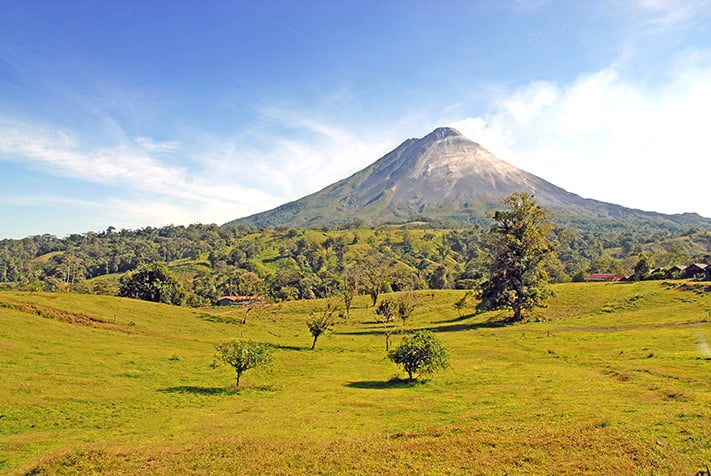
When you travel to Costa Rica it’s likely you’ll consider another option, more suited for beach lovers, by doing an about face and heading four hours due south to Manuel Antonio Beach - here the surfing, parasailing, and ability to drink out of a coconut are just too tempting. The nightlife scene in the town of Quepos is a welcome burst of civilization after a week in the jungle.
From Quepos you can head further south to Playa Uvita and its coral reef and crystal clear waters perfect for scuba diving and snorkeling. The humpback whale migration here between December and April is a highlight.
If you’re up North in Liberia the logical next step is to head to the Nicoya Peninsula for more stunning beaches and a great look into small town Costa Rican life. This option is also doable from Manuel Antonio but it’s about six hours. Another good option is to cross to the Caribbean side to the city of Cahuita and its white and black sand beaches and Afro-Caribbean culture.
Leave 3-4 days minimum in each place and you’ll have a good two week itinerary planned. To pad it up over a longer period make sure to check out other hot spots like Tortuguero, Montezuma, and Manzanillo.
Budget
For a meal in an inexpensive restaurant in Costa Rica expect to pay about €6.50 per person. If you go up the ladder a bit and decide to splash out for a three-course meal at a mid-range restaurant expect to pay €28-€32 for two people. A full pint of domestic beer will run you about €1.80 while a bottle of water costs about €1 - expect to pay about 10-15% higher than the mean in San Jose and other tourist destinations and about 10-15% lower in less visited rural areas.
Accommodation in Costa Rica breaks down much like other backpacking stops and it naturally starts with hostels. Expect to pay between €8-€16 a night for a standard hostel. The guest house scene here is quite active due to the influx of tourists and you should be ready to pay between €20-€35 a night whether it’s via Airbnb or independents. You’ll get a mid-range hotel for about €50-€70 a night and the prices rise from there to the €85-€200+ range for resorts and upscale hotels.
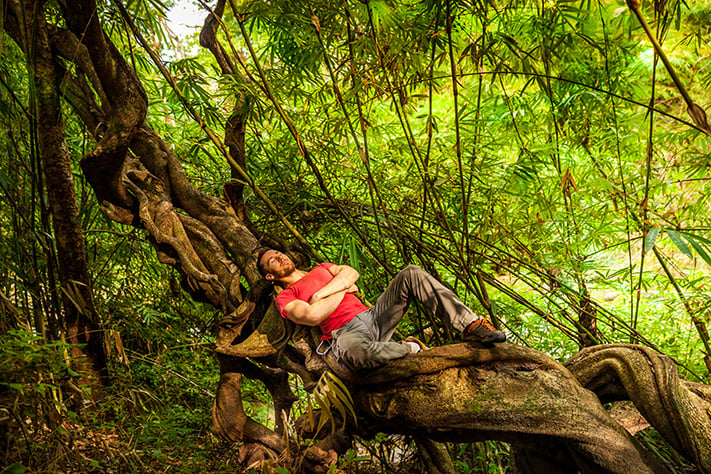
One optional expense which most people go for is to take a guided tour of some of the best parks and nature reserves. An average guided tour price is €25-€30 depending on the popularity of the destination. The good thing about Costa Rica’s nature is that seeing it is independently is free! You won’t spend a lot on cheesy souvenirs, gimmicky wax museum-esque traps, and overpriced tourist restaurants with picture menus.
A budget conscious backpacker can get by on €25 a day while those looking to do a few planned excursions, sip a couple beers, and do the odd surf lesson will spend about €50-€65.
Getting around
The most comfortable is Ticabus. For a higher price tag you can get in on the faster, air conditioned carriers Grey Line and Interbus but this is only recommended for people short on time.
Natureair is the most reliable in the country and is known to backpackers for its famous Natureair Pass which allows you unlimited plane travel over a specified period (about €400/€700 for 2/4 weeks). Otherwise short domestic flights run from about €45-€90 one way.
Make sure they run the meter and expect to pay about €1 per kilometer.
Tips
As with most places there are high seasons and low seasons and which you pick could make a massive difference to your budget. In general a trip to Costa Rica will cost you much less in the rainy season (late April to November) due to less tourist traffic. In the US winter months the country swells with American tourists taking their Costa Rica trips.
Another perhaps obvious tip is take your time. The relaxing natural settings straight out of postcards won’t do you much good if you’re crammed onto a stuffy bus every second day. You’ll also get the most out of your trip (especially in rainy season) by starting your day early. Often some of the best weather is found early in the morning before the heavy afternoon rains.

When you arrive, don’t panic and change your money right at the airport because you’ll be gouged with some of the worst rates anywhere. Instead try and change your money at your hotel. Once you’ve got your money one thing to consider depending on how much you’ve read up on locations yourself is to hire a tour guide for any park nature reserve - just make sure the guide specifies whether it’s private or will include other tourists.
Go camping. Tons of resorts and hotels will let you pitch your tent on their property for as little as €4 a night and this could be a big money saver in the long run. Another money saving tip is to eat in the local sodas - these family run restaurants similar to North American diners will get you a quality, inexpensive meal of slow-cooked meat with rice and a succulent sauce for as little as €2.
When to go
We'll tell you the best time to do this backpacking trip through Costa Rica. Take notes and start preparing your trip!


Do you feel like travelling?
Discover the best flight offers to fly to San Jose in Costa Rica
Related blog articles
These blog articles might interest you...
